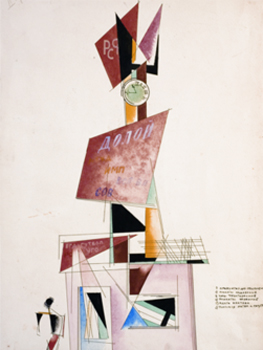
MNCARS is exhibiting the most comprehensive show in Spain to date devoted to both Russian artists
Rodchenko
Lilia Brik. Courtesy Pace/Mac Gill Gallery, Edwynn Houk Gallery and Galerie Rudolf Kicken
“Rodchenko and Popova: Defining Constructivism”
MUSEO NACIONAL CENTRO DE ARTE REINA SOFÍA
c/ Santa Isabel, 52
28012 Madrid
From the 20th october 2009 to the 11th january 2010
A broad-ranging sample of both the better and lesser known works of Aleksandr Rodchenko and Liubov Popova is on display at MNCARS in what is slated to be one of the most important shows in Madrid this season. The exhibition aims to analyze the role of these two Russian creators in the genesis of Constructivism, a movement that emerged in 1917, the same year as the Russian Revolution. The goal of Constructivism was to embark on a creative revolution parallel to the social one, and to question the fundamental principles of art that had been in place until then and the purpose of art in the new society.
Linking creation and engineering, the Constructivists advocated a rational, scientific production of works of art, parallel to the process of manufacturing any other product, and they sought strategies to improve everyday life through the impetus of artistic activity. They went so far as to suggest the use of collective labor mechanisms in this realm, too. As core figures in the consolidation of Constructivism, Rodchenko and Popova developed an extensive oeuvre that ventured beyond the traditional fields of painting and sculpture to encompass furniture and clothing, poster design and theoretical musings. Likewise, it is no coincidence that the artists chosen to represent the development of this trend in this show are a man and a woman: Popova’s works were crucial to the birth of the Constructivist movement, a current much more closely tied to women than any other before it.
This show, which is virtually encyclopedic because of both the number of works displayed (350) and its educational aim, is organized into two parts. The first includes paintings, drawings and sculptures linked to the geometric abstraction that both Popova and Rodchenko practiced between 1917 and 1921. In the latter year, their works were shown in the collective exhibition 5×5 = 25. The second part compiles their output thereafter, ushering in a stage in which they would strive to apply the Constructivist concepts to the fields of advertising, book design, film, theatre and the textile industry.
In addition to Popova and Rodchenko, other participants in 5×5 = 25 included Vesnin, Exter and Stepanova. That exhibition was also organized into two parts separated by time: the first one was envisioned as a farewell to painting in its traditional conception; it included five works by each of the aforementioned artists. The second had its sights set on the future, stressing art’s potential to contribute to progress and play an active role in society. In this second show, paintings were not represented; only drawings and models were displayed, several of which, such as Rodchenko’s triptych Pure Red Color, Pure Yellow Color, Pure Blue Color and Popova’s Space-Force Construction No. 80, can be seen at the Reina Sofía.
As a pioneer of abstraction, Kandinsky exerted a crucial influence on the works of the artists spotlighted in this exhibition, just as Bolshevik ideology was an indissociable part of their works, as it could only be spread among an illiterate people through innovative visual designs like the ones Popova and Rodchenko applied in their propaganda and educational posters. Both came to design such apparently trivial items as cigarette boxes, fabrics and coffee cups in order to add their grain of sand to the improvements in domestic life that was so glorified in Russia in the 1920s.
Film and theatre are also represented in this large-scale exhibition being hosted by MNCARS, given that Rodchenko collaborated with some of the most prominent Soviet filmmakers of his day, and Popova designed sets and models for Meirkhol’d and costumes for his actors.
The exhibition “Rodchenko and Popova: Defining Constructivism” closes with a replica of a space set aside for collective leisure designed for the International Exhibition of Decorative Arts and Modern Industry held in Paris in 1925, along with two films by Kuleshov and Barnet: The Female Journalist and Moscow in October. Rodchenko designed the sets for the former and was the artistic director of the latter.
Parallel to this show at the Reina Sofía, between the 23rd of October and the 3rd of January, the Canal Foundation will display more than 120 instant snapshots taken by Rodchenko between 1920 and 1940, on loan from the Musée Nicéphore Niépce in Chalon sur Saône (France).

Liubov Popova, 1921

Alexander Rodchenko. Design for a Kiosk 1919
© A Rodchenko & V Stepanova Archive / DACS 2009. Private collection




